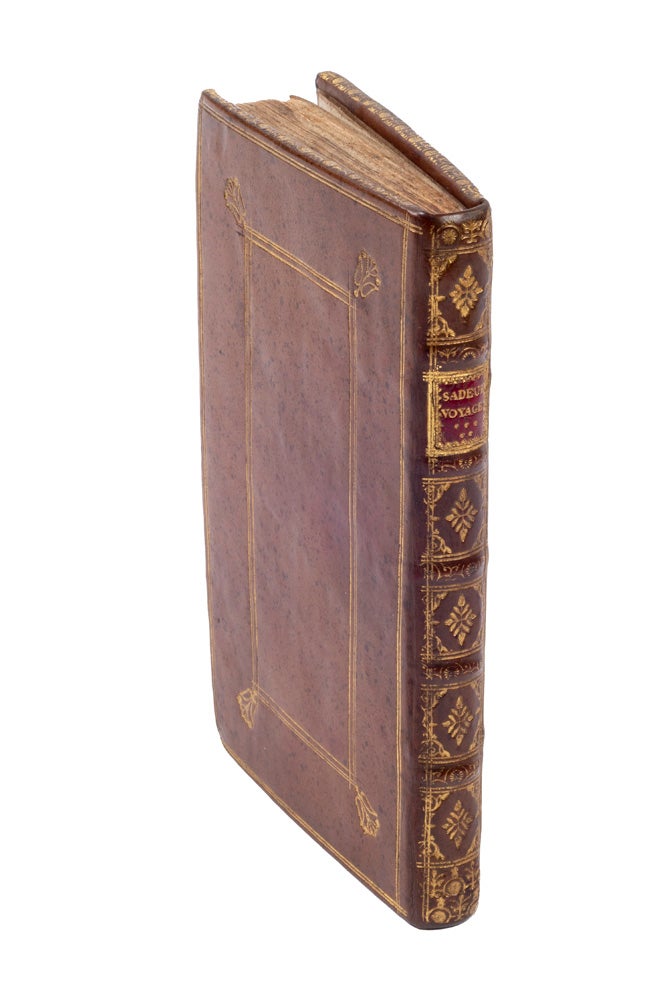A New Discovery of Terra Incognita Australis, or the Southern World…
A New Discovery of Terra Incognita Australis, or the Southern World by James Sadeur a French-man…
London: for John Dunton, 1693.
Duodecimo, with the three advertisement leaves at the end; small paper flaw to pp. 177-8; a very attractive copy in full speckled calf, spine ornately gilt, sides panelled in gilt.
An antipodean utopia: first use of the words "Australia" and "Australian" in print
The very rare and valuable first English edition of this remarkable imaginary voyage, in which Jacques Sadeur makes his way to the southern land and discovers in western Australia an idealised society of large-bodied hermaphrodites who live in harmony with one another. This English language printing of 1693 contains the very first usage of the words 'Australia' and 'Australian' in print. Ordinarily Matthew Flinders is credited as having been the first published author of the name 'Australia', as it appears in his Voyage to Terra Australis. However, Foigny's fantastic story predates this by more than a century. First published in French in Switzerland in 1676 (where it was promptly banned by church authorities), the book was republished in several locations. This important first edition in English of 1693 is notably rare.
The very rare and valuable first English edition of this remarkable imaginary voyage, in which Jacques Sadeur makes his way to the southern land and discovers in western Australia an idealised society of large-bodied hermaphrodites who live in harmony with one another. This English language printing of 1693 contains the very first usage of the words 'Australia' and 'Australian' in print. Ordinarily Matthew Flinders is credited as having been the first published author of the name 'Australia', as it appears in his Voyage to Terra Australis. However, Foigny's fantastic story predates this by more than a century. First published in French in Switzerland in 1676 (where it was promptly banned by church authorities), the book was republished in several locations. This important first edition in English of 1693 is notably rare.
Gabriel de Foigny (c.1650-1692) had a turbulent life: a rebellious and libertine character, 'constantly at loggerheads with the church authorities on account of his deplorable lifestyle and unacceptable behaviour' (Howgego), his career as a Franciscan monk was cut short by his 'licentious behaviour' and he was forced to flee to Geneva and Protestantism. It was during this self-imposed exile that his tale of Jacques Sadeur first appeared, anonymously, in 1676.
The story purports to be the dying gift of the sailor Sadeur to an anonymous narrator. Twice kidnapped and four times shipwrecked, Sadeur only survives when he is plucked from the sea by a gigantic winged monster which fortuitously drops him on the western shores of Australia. Ashore, his luck continues: as an hermaphrodite himself Sadeur is especially acceptable to the hermaphroditic, asexual society that he discovers in the west.
In the preamble to the book, Foigny leans on the reputations of Marco Polo, Magellan and de Quirós to bolster the credibility of his description of the amazing southern continent, and even claims to have received written testimony from Sadeur himself. Indeed, a contemporary English newspaper account presented this publication as an authentic and factual voyage account!
The Australians' utopian rejection of the body is responsible for their society's rationality and harmony. In this world Sadeur's curiosity and levity about the topic is considered de trop, yet worse his 'propensity to unseemly arousal' (Rees). An important work, which combines several major traditions, it is 'a major utopia, rich in satire and iconoclasm' (Gibson) and presents a narrative response to the strict regimentation of the utopia, particularly in the context of the Pacific (Spate comments: 'in part at least a send-up of Quirós'). Moreover, it is one of the most justly famous examples of the sustained use of realistic framing devices, including the key importance afforded to the role of the imagined Austral continent.
Davidson, 'A Book Collector's Notes', pp. 41-2; Fausett, 'The Southern Land, Known', p. 144; Gibson, 'St. Thomas More… with a Bibliography of Utopiana', 682; Spate, p. 83.
Condition Report: Some margins cut a little close, small stain on the title-page.
Price (AUD): $48,000.00
US$30,763.09 Other currencies



